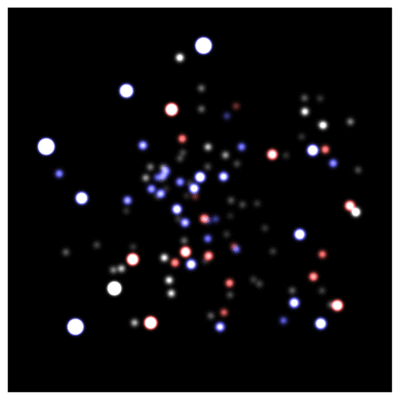Results - The Dance of Stars
For the first time, our team was able to determine the orbits of nearly 30 stars in the Galactic Center. The motions of these stars in the central light month of the Milky Way resemble a swarm of bees around their stack. The stars move quickly and on randomly oriented orbits. The tracks are highly elliptical, much more elliptical than Earth's orbit around the Sun. And surprisingly, the swarm of stars consists of young stars - so young that it is enigmatic how they can reside so close to the massive black hole. Due to the gravity monster the stars cannot have formed where they are seen today, still they are too young to have migrated from far.
 Movement of stars in the central 3 arcseconds from 1992 to 2008. Young stars are color-coded in blue, while members of the old population are colored red.
Movement of stars in the central 3 arcseconds from 1992 to 2008. Young stars are color-coded in blue, while members of the old population are colored red.
The center of the Milky Way is one of the most fascinating regions that astronomers can have a look at. It harbors a black hole with a mass four million times larger than the mass of the Sun and it lies at a very moderate distance of only 25000 light years, which allowed the astronomers to make measurements with unprecedented precision. The galactic centre harbors the closest massive black hole known, which in turn is also the largest in terms of angular diameter on-sky. Hence, it is the best to choice to study black holes in detail. We have been observing the Galactic Center for 17 years using modern telescopes and forefront instrumentation. The result is the most detailed picture of the innermost region of our Milky Way ever. High precision astrometry and spectroscopy allowed us to follow the tracks of stars in the gravitational potential of the black hole. The stars are used here as test particles that map out the field of forces in which they move - similar to dust in the wind showing the motion of air. Undoubtedly the most spectacular aspect of our long term study is that it has delivered what is now considered the best empirical evidence that massive black holes exist. The stellar orbits in the galactic centre show that the central mass concentration of four million solar masses must be a black hole, beyond any reasonable doubt.
The new study also yields the mass of and the distance to Sgr A* - that's how astronomers call the black hole in the Milky Way Center. The name indicates that it is a bright, compact radio source in the constellation Sagittarius. Sgr A* is a single black hole, and any other mass in its vicinity must be less massive than few percent the mass of the big black hole. This result from the German astronomers is mainly based on the spectacular orbit of one star, which our team named in 1994 simply S2. That star orbits the black hole in just 15 years, a bit longer than it takes Jupiter to make its way around the Sun.
Observing the center of the Milky Way is of uttermost interest - and at the same time it is a technological challenge. The interstellar dust in the Milky Way obscures the view towards the Galactic Center. Only radio signals, infrared light and X-rays can reach us from the galactic centre. While radio observations show mostly gas and X-ray observatories are sensitive to high-energy processes, it is the infrared that allows for the observation of stars. Working with infrared light is laborious. Detectors are costly, the instruments need to be cooled and only the largest telescopes offer sufficient angular resolution to observe the scenery in the Milky Way core with the detail needed here. The first ten years we were using the custom-made camera SHARP at ESO's 3.5 meter New Technology Telescope, located at La Silla in Chile. Since 2002, we were able to switch to ESO's Very Large Telescope on Paranal in Chile, offering a larger 8.2 meter mirror and active compensation of the atmospheric distortions of the images.
The centre of the Galaxy is a unique laboratory where we can study fundamental processes of strong gravity, stellar dynamics and star formation that are of great relevance to all other galactic nuclei, at a detail and resolution, that will not ever be possible outside of the galactic centre.